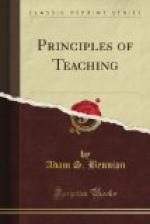1 pupil did 3 examples correctly
2 pupils did 4 examples correctly
1 pupil did 5 examples correctly
5 pupils did 6 examples correctly
2 pupils did 7 examples correctly
4 pupils did 8 examples correctly
6 pupils did 9 examples correctly
14 pupils did 10 examples correctly
8 pupils did 11 examples correctly
7 pupils did 12 examples correctly
8 pupils did 13 examples correctly
5 pupils did 14 examples correctly
5 pupils did 15 examples correctly
6 pupils did 16 examples correctly
1 pupil did 17 examples correctly
5 pupils did 18 examples correctly
1 pupil did 19 examples correctly
2 pupils did 20 examples correctly
The rapidity of movement of ten-year-old girls, as measured by the number of crosses made in a fixed time:
6 or 7 by 1 girl 8 or 9 by 0 girl 10 or 11 by 4 girls 12 or 13 by 3 girls 14 or 15 by 21 girls 16 or 17 by 29 girls 18 or 19 by 33 girls 20 or 21 by 13 girls 22 or 23 by 15 girls 24 or 25 by 11 girls 26 or 27 by 5 girls 28 or 29 by 2 girls 30 or 31 by 5 girls 32 or 33 by 3 girls 34 or 35 by 5 girls 36 or 37 by 0 girl 38 or 49 by 4 girls 40 or 41 by 1 girl
Two papers, A and B, written by members of the same grade and class in a test in spelling:
A. B. greatful gratful elegant eleagent present present patience paisionce succeed suckseed severe survere accident axadent sometimes sometimes sensible sensible business biusness answer anser sweeping sweping properly prooling improvement improvment fatiguing fegting anxious anxchus appreciate apresheating assure ashure imagine amagen praise prasy
In a test in spelling wherein fifty common words were dictated to a class of twenty-eight pupils, the following results were obtained:
2 spelled correctly all 50
3 spelled correctly between 45 and
48
5 spelled correctly between 40 and
45
11 spelled correctly between 30 and 40
6 spelled correctly between 20 and
30
1 spelled correctly between 15 and
20
And now the question—what has all this to do with the teaching of religion? Just this: the differences among men as found in fields already referred to, are found also in matters of religion. For one man it is easy to believe in visions and all other heavenly manifestations; for another it is next to impossible. To one man the resurrection is the one great reality; to another it is merely a matter of conjecture. One man feels certain that his prayers are heard and answered; another feels equally certain that they cannot be. One man is emotionally spiritual; another is coldly hard-headed and matter-of-fact. The point is not a question which man is right—it is rather that we ought not to attempt to reach each man in exactly the same way, nor should we expect each one to measure up to the standards of the others.




